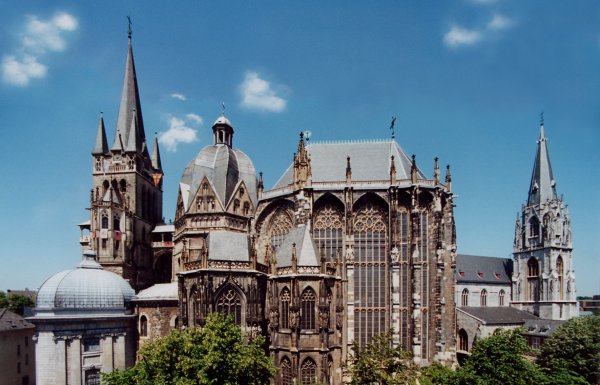The Starbucks I am using for internet lies about twenty
minutes walk from my hostel. This is admittedly a bit inconvenient. However,
the sights I pass on that walk make it well worth my time.
The jumbled sidewalks
and roads blend together into one cobblestoned mass where pedestrians go where
they will. Rising up from the center of that tangle is the Aachen Cathedral
(Aachener Dom). Built by Karl der Große, known to Americans as Charlemagne, it
has existed more than 1200 years. It has aged well. Carvings of saints and
biblical figures decorate the external columns marking where angled walls meet.
Between these columns stand arched windows. In the walls forming the choir hall,
the windows extend from just above a man’s reach to just below the roof’s
gargoyles and spires. The glass appears black in the light of day from outside.
A trip inside reveals the truth. The windows glow with royal hues of every
color. The stained glass depicts a myriad of pictures. Behind the ropes keeping
visitors away from the choir seats and altar, those pictures remain abstract.
The rest of the interior is no less impressive. Marble decks
the floors and lower walls. Mosaics decorate the ceilings. The domed ceiling in
the octagonal main body of the cathedral shows men all around its rim standing
in admiration of an enormous image of Christ enthroned. Pillars, ranging from
black to white to purple, ring the dome. The lower ceilings outside this circle
of marble sport mosaic vines and flowers. Everywhere I looked a new piece of
art caught my eye. I have always thought of such elaborate buildings as vain,
unnecessary things. While I still prefer a plainer church for my own worship, I
can understand a cathedral’s purpose. It is not to make the churchgoers feel
rich. It is to make them feel small and the church immeasurably large.
Not surprisingly, a
number of other sights of interest have cropped up beside the cathedral. The
Rathaus (town hall) stands just across the way. I have only seen the outside,
as one has to pay to enter. Although squarer and squatter than the cathedral
the Rathaus still displays statues, a tower or two, and ornate gothic
stonework. On the wide grey steps a wedding procession took photographs when I
first approached it. Across the cobblestones a metal casting of Karl der Große
looms in the center of a fountain. It all looks quite officious.
However, not far away, amidst the quaint shops surrounding
the Dom, a far more interesting fountain gurgles. It is called the
Puppenbrunnen, literally doll fountain. The name suits it. Metal puppets with
articulated joints circle the water spouts. A mounted knight and rooster crown
the collection while metal Carnival masks cover one side. The fountain comes
dangerously close to the uncanny valley, that dramatic plunge into creepiness
when an object is not quite human. I
would not want to sleep next to it. However, it has one big advantage going for
it; it is interactive. Visitors are expected to play with the puppets,
positioning their arms and legs as they desire. For kinesthetic learners like
me, that physical interaction boosts its appeal considerably. Unlike the
Karlsbrunnen which has existed for centuries, the Puppenbrunnen came about in
the 1970s. Alas, not everything in the city is ancient.





No comments:
Post a Comment